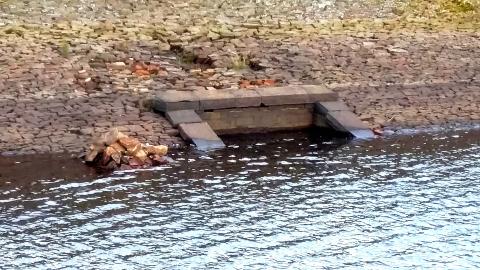A Few More Puzzling Pictures Explained
If you’re still puzzled by the pictures that appeared in the entry for 24.10.2017, then here are another two photographs to help you.
1: Way Down Low
2: Several Feet Higher And Still Rising

Yes, we’re back at Clowbridge reservoir, where the water level dropped dramatically during recent engineering works, revealing traces of the lost village of Gambleside for several months.
All of these items are now back under the water, since the conclusion of the works and the recent rains which brought the level back to normal.
Picture one shows the stones lining the sloping sides of the reservoir - taken, presumably, from walls and buildings in the abandoned village. See picture four for the base of one of these walls and another view of the reservoir’s edge. Picture two is the trunk of a large tree. I’m amazed that so much of it remains, after being submerged for so many years. Picture three is the odd man out. This fearsome-looking fish must have been stranded in the shallows when the water went down; normally in his element under the waves, he was not an original part of this little lost world.
If you want to know more about the village of Gambleside, then may I invite you to take a walk around the reservoir itself, and in the hills just above it. Here and there you will find notice boards bearing old photographs and information about the area’s past.
And, if you search for it long enough, you will find an open-air baptistry! The first time I saw it, I wondered what it was doing out there in the middle of nowhere. Let me leave you with an extract from an article in the Rossendale Free Press, written by Phillip Adkinson of Clowbridge, which I quote with acknowledgements.
It was on Christmas Day 1839 that the officials of the Baptist Church in Clowbridge met and arranged to rent an old house in Gambleside, overlooking the fields where the Clowbridge reservoir is now, as a meeting place for preaching and worship. No official meeting place or church had existed prior to that date and the meetings had been held in the homes of the people.
On the first day of January 1840, when it was bitterly cold with the snow falling, the first meeting in the new building was held. There was no heating in the room and the only seating was on wooden planks covered by sacks provided by the farmer from whom the house was rented. The first congregation consisted of a few farmers, miners and mill operatives. A Sunday school for the children was started at the same place on the same day.
It speaks well for the fervour and devotion of these early Baptists that the church grew and prospered in spite of these hardships and in 1843 an old brewhouse was taken over and converted into a chapel.
During these years many baptisms were carried out in a baptismal pit by the chapel. Baptisms were carried out in hot weather when hundreds of people could be seen dotting the hillside leading up from the water. Others were held in winter when the water was icy and those who had been baptised were doubtless glad to change back into their clothes at one of the neighbouring farms.
The death knell of Gambleside as a community was sounded in 1866 with the completion of the Clowbridge reservoir and the consequent restrictions on farming. It is significant that in November of the same year a schoolroom and dwelling house were opened at Clowbridge "nearer the population" by the Baptists. This building in time took over the functions of Gambleside Chapel.
Today, however, there is no longer a chapel at Clowbridge, and apart from a Sunday school which is still held, the building is used as a primary school. And there is little to show where Gambleside once stood except a few heaps of stones and half dead sycamore trees lining Limey Lane which ran through the hamlet. Yet the fervour displayed there should inspire us all.
- Log in to post comments


 Sunday Worship 10.45am & 6.00pm
Sunday Worship 10.45am & 6.00pm